Simulated Effects of Future Water Availability and Protected Species Habitat in a Perennial Wetland, Santa Barbara County, California
Abstract
:1. Introduction
2. Materials and Methods
2.1. Extended San Antonio Creek Integrated Model
2.2. Future San Antonio Creek Integrated Model
2.3. Qualitative Evaluation of Barka Slough Aquatic Habitat
3. Results
3.1. Water Availability in the San Antonio Creek Valley Watershed
3.1.1. Precipitation and Temperature
3.1.2. Groundwater Budget
3.2. Water Availability in Barka Slough
3.2.1. Surface Water Flow
3.2.2. Groundwater Budget for Barka Slough
3.2.3. Vertical Groundwater Flow Gradients
3.3. Effects on Aquatic Habitat
3.3.1. Streamflow
3.3.2. Stream Disconnection
3.3.3. Depth to Groundwater
4. Discussion
5. Conclusions
- Changes to streamflow in San Antonio Creek under 2070 DEW climatic conditions may affect habitat for the tidewater goby and unarmored threespine stickleback. These species are adapted to variable streamflow and precipitation conditions, and, therefore, future changes to streamflow may have a limited impact on the species.
- Changes to stream disconnection along San Antonio Creek are likely to affect the unarmored threespine stickleback. This fish may face poor habitat conditions and predation during periods when reaches of the creek are disconnected, and the fish may be constrained in seeking out refuge or more beneficial environmental conditions.
- Changes in the depth to groundwater in Barka Slough under 2070 DEW conditions are likely to affect the Gambel’s watercress and La Graciosa thistle—these riparian plants are likely to be stressed without a groundwater contribution to the root zone and will need to rely solely on surface water or other sources of water.
Author Contributions
Funding
Data Availability Statement
Acknowledgments
Conflicts of Interest
Abbreviations
| SACVW | San Antonio Creek Valley watershed |
| 2070 DEW | 2070-centered Drier Extreme Warming |
| SACIM | San Antonio Creek integrated model |
| SACIMF | future San Antonio Creek integrated model |
| SACIMF.1 | future San Antonio Creek integrated model with historical climate inputs |
| SACIMF.2 | future San Antonio Creek integrated model with 2070 DEW climate inputs |
| ET | evapotranspiration |
| km | kilometers |
| m | meters |
| cms | cubic meters per second |
| Mm3/yr | million cubic meters per year |
Appendix A
Appendix A.1. Tidewater Goby
Appendix A.2. Unarmored Threespine Stickleback
Appendix A.3. California Red-Legged Frog
Appendix A.4. Gambel’s Watercress
Appendix A.5. La Graciosa Thistle
References
- Cromwell, G.; Sweetkind, D.S.; Densmore, J.N.; Engott, J.A.; Seymour, W.A.; Larsen, J.D.; Ely, C.P.; Stamos, C.L.; Faunt, C.C. Hydrogeologic Characterization of the San Antonio Creek Valley Watershed, Santa Barbara County, California; Scientific Investigations Report 2022-5001; U.S. Geological Survey: Reston, VA, USA, 2022; p. 124. Available online: https://pubs.usgs.gov/publication/sir20225001 (accessed on 24 May 2023).
- Flint, L.E.; Flint, A.L. Simulation of Climate Change in San Francisco Bay Basins, California: Case Studies in the Russian River Valley and Santa Cruz Mountains; U.S. Geological Survey Scientific Investigations Report 2012-5132; U.S. Geological Survey: Reston, VA, USA, 2012; p. 55. [CrossRef]
- Martin, P. Development and Calibration of a Two-Dimensional Digital Model for the Analysis of the Ground-Water Flow System in the San Antonio Creek Valley, Santa Barbara County, California; U.S. Geological Survey Water-Resources Investigation Report 84-4340; U.S. Geological Survey: Reston, VA, USA, 1985. [CrossRef]
- Woolfenden, L.R.; Engott, J.A.; Larsen, J.D.; Cromwell, G. Simulation of Groundwater and Surface-Water Resources of the San Antonio Creek Valley Watershed, Santa Barbara County, California; U.S. Geological Survey Scientific Investigations Report 2021-5139; U.S. Geological Survey: Reston, VA, USA, 2022; p. 76. [CrossRef]
- Culling, D.; Larsen, J.D.; Engott, J.A.; Seymour, W.A.; Cromwell, G. GSFLOW model to extend the San Antonio Creek Integrated Model and simulate future water availability scenarios, San Antonio Creek Valley watershed, Santa Barbara County, California; U.S. Geological Survey Data Release; USGS: Reston, VA, USA, 2025. [CrossRef]
- US Fish and Wildlife Service. Recovery Plan for the Tidewater Goby (Eucyclogobius newberryi); U.S. Fish and Wildlife Service: Portland, OR, USA, 2005; p. 205. Available online: https://ecos.fws.gov/docs/recovery_plan/051207.pdf (accessed on 13 February 2023).
- US Fish and Wildlife Service. Unarmored Three-Spine Stickleback Recovery Plan (Revised); U.S. Fish and Wildlife Service: Portland, OR, USA, 1985; p. 90. Available online: https://ecos.fws.gov/docs/recovery_plan/Revised%20UTS%20RP.pdf (accessed on 6 January 2023).
- US Fish and Wildlife Service. Unarmored Three-Spine Stickleback (Gasterosteus aculeatus williamsoni) 5-Year Review: Summary and Evaluation; Ventura Fish and Wildlife Office: Ventura, CA, USA, 2021; p. 21. Available online: https://ecos.fws.gov/docs/tess/species_nonpublish/944.pdf (accessed on 6 January 2023).
- US Fish and Wildlife Service. Recovery Plan for the California Red-legged Frog (Rana aurora draytonii); U.S. Fish and Wildlife Service: Portland, OR, USA, 2002; p. 180. Available online: https://ecos.fws.gov/docs/recovery_plan/020528.pdf (accessed on 6 January 2023).
- US Fish and Wildlife Service. California Redlegged Frog (Rana draytonii) 5-Year Review: Summary and Evaluation; U.S. Fish and Wildlife Service: Sacramento, CA, USA, 2022; p. 44. Available online: https://ecos.fws.gov/docs/tess/species_nonpublish/4025.pdf (accessed on 6 January 2023).
- US Fish and Wildlife Service. Recovery Plan for Marsh Sandwort (Arenaria Paludicola) and Gambel’s Watercress (Rorippa Gambelii); US Fish and Wildlife Service: Portland, OR, USA, 1998; p. 63. Available online: https://ecos.fws.gov/docs/recovery_plan/980928b.pdf (accessed on 26 January 2023).
- US Fish and Wildlife Service. Gambel’s Watercress (Nasturtium gambelii [Rorippa gambellii]) 5-Year Review: Evaluation and Summary; U.S. Fish and Wildlife Service: Ventura, CA, USA, 2022; p. 14. Available online: https://ecos.fws.gov/docs/tess/species_nonpublish/3673.pdf (accessed on 26 January 2023).
- US Fish and Wildlife Service. Cirsium loncholepis [Cirsium scariosum var. loncholepis] (La Graciosa thistle) 5-Year Review: Evaluation and Summary; U.S. Fish and Wildlife Service: Ventura, CA, USA, 2011; p. 36. Available online: https://ecos.fws.gov/docs/tess/species_nonpublish/1716.pdf (accessed on 20 January 2023).
- US Fish and Wildlife Service. La Graciosa Thistle (Cirsium scariosum var. loncholepis) Recovery Plan; U.S. Fish and Wildlife Service: Ventura, CA, USA, 2021; p. 14. Available online: https://ecos.fws.gov/docs/recovery_plan/Recovery%20Plan%20for%20La%20Graciosa%20Thistle.pdf (accessed on 20 January 2023).
- California Department of Water Resources. 1996 South Central Coast Land Use Survey; California Department of Water Resources: Sacramento, CA, USA, 2000. Available online: https://water.ca.gov/Programs/Water-Use-And-Efficiency/Land-And-Water-Use/Land-Use-Surveys (accessed on 1 November 2018).
- California Department of Conservation. Farmland Mapping & Monitoring Program; California Department of Conservation: Sacramento, CA, USA, 2018. Available online: https://www.conservation.ca.gov/dlrp/fmmp (accessed on 26 October 2018).
- Muir, K.S. Geology and Ground Water of San Antonio Creek Valley, Santa Barbara County, California; U.S. Geological Survey Professional Paper 1664; USGS: Reston, VA, USA, 1964; p. 53. [CrossRef]
- Hutchinson, C.B. Appraisal of Groundwater Resources in the San Antonio Creek Valley, Santa Barbara County, California; U.S. Geological Survey Open-File Report 80–750; USGS: Reston, VA, USA, 1980; p. 48. [CrossRef]
- Kløve, B.; Ala-Aho, P.; Bertrand, G.; Gurdak, J.J.; Kupfersberger, H.; Kværner, J.; Muotka, T.; Mykrä, H.; Preda, E.; Rossi, P.; et al. Climate change impacts on groundwater and dependent ecosystems. J. Hydrol. 2014, 518, 250–266. [Google Scholar] [CrossRef]
- Markstrom, S.L.; Niswonger, R.G.; Regan, R.S.; Prudic, D.E.; Barlow, P.M. GSFLOW-Coupled Ground-Water Surface-Water Flow Model Based on the Integration of the Precipitation-Runoff Modeling System (PRMS) and the Modular Ground-Water Flow Model (MODFLOW-2005); U.S. Geological Survey Techniques and Methods 6–D1; USGS: Reston, VA, USA, 2008; p. 240. [CrossRef]
- Regan, R.S.; Niswonger, R.G. GSFLOW Version 2.2.0—Coupled Groundwater and Surface-Water Flow Model; U.S. Geological Survey Software Release; USGS: Reston, VA, USA, 2021.
- California Department of Water Resources. 2070 Extreme Climate Change Scenarios for Water Supply Planning; California Department of Water Resources: Sacramento, CA, USA, 2020. Available online: https://data.ca.gov/dataset/2070-extreme-climate-change-scenarios-for-water-supply-planning (accessed on 18 February 2023).
- California Irrigation Management Information System. CIMIS Station Reports. 2017. Available online: https://cimis.water.ca.gov/ (accessed on 24 February 2023).
- National Centers for Environmental Information. Global Historical Climatology Network—Daily, Ver. 3. 2022. Available online: https://www.ncei.noaa.gov/access/search/data-search/daily-summaries (accessed on 31 August 2022).
- Santa Barbara County. Daily Rainfall Data. 2022. Available online: https://www.countyofsb.org/2328/Daily-Rainfall-Data-XLS (accessed on 31 August 2022).
- California Department of Water Resources. SGMA Data Viewer: California Department of Water Resources Sustainable Groundwater Management Program; California Department of Water Resources: Sacramento, CA, USA, 2022. Available online: https://www.water.ca.gov/Programs/Groundwater-Management/Data-and-Tools (accessed on 25 October 2022).
- US Geological Survey. USGS Water Data for the Nation; U.S. Geological Survey National Water Information System Database; USGS: Reston, VA, USA, 2022. [CrossRef]
- Larsen, J.D.; Alzraiee, A.; Niswonger, R. pyGSFLOW v100: U.S. Geological Survey Software Release; USGS: Reston, VA, USA, 2021. [CrossRef]
- Larsen, J.D.; Alzraiee, A.H.; Martin, D.; Niswonger, R.G. Rapid model development for GSFLOW with Python and pyGSFLOW. Front. Earth Sci. 2022, 10. [Google Scholar] [CrossRef]
- Larsen, J.D.; Alzraiee, A.; Niswonger, R.G. Integrated hydrologic model development and postprocessing for GSFLOW using pyGSFLOW. J. Open Source Softw. 2022, 7, 3852. [Google Scholar] [CrossRef]
- Hughes, J.D.; Langevin, C.D.; Paulinski, S.R.; Larsen, J.D.; Brakenhoff, D. FloPy Workflows for Creating Structured and Unstructured MODFLOW Models. Groundwater 2023, 62, 124–139. [Google Scholar] [CrossRef] [PubMed]
- Bakker, M.; Post, V.; Hughes, J.D.; Langevin, C.D.; White, J.T.; Leaf, A.T.; Paulinski, S.R.; Bellino, J.C.; Morway, E.D.; Toews, M.W.; et al. FloPy v3.7.0: U.S. Geological Survey Software Release; USGS: Reston, VA, USA, 2024. [CrossRef]
- California Department of Water Resources. Statewide Crop Mapping GIS Shapefile; California Department of Water Resources: Sacramento, CA, USA, 2019. Available online: https://data.cnra.ca.gov/dataset/statewide-crop-mapping/resource/1da7b37a-dd97-4b69-a86a-fe824a252eaf (accessed on 15 August 2022).
- LANDFIRE 2020 Update. Existing Vegetation Type Layer, LANDFIRE 2.2.0: U.S. Department of the Interior, U.S. Geological Survey. 2022. Available online: https://landfire.gov/version_download.php (accessed on 22 August 2022).
- Markstrom, S.L.; Regan, R.S.; Hay, L.E.; Viger, R.J.; Webb, R.M.T.; Payn, R.A.; LaFontaine, J.H. PRMS-IV, the Precipitation-Runoff Modeling System, Version 4; U.S. Geological Survey Techniques and Methods 6–B7; USGS: Reston, VA, USA, 2015; p. 158. [CrossRef]
- US Geological Survey. National Hydrography Dataset (Ver. USGS Hydrography Dataset Best Resolution (NHD) for Hydrologic Unit (HU) 8-18060009 (Published 20161230)); USGS: Reston, VA, USA, 2016. Available online: https://www.usgs.gov/national-hydrography/national-hydrography-dataset (accessed on 19 January 2017).
- Feng, D.; Beighley, E.; Raoufi, R.; Melack, J.; Zhao, Y.; Iacobellis, S.; Cayan, D. Propagation of future climate conditions into hydrologic response from coastal southern California watersheds. Clim. Change 2019, 153, 199–218. [Google Scholar] [CrossRef]
- Falke, J.A.; Fausch, K.D.; Magelky, R.; Aldred, A.; Durnford, D.S.; Riley, L.K.; Oad, R. The role of groundwater pumping and drought in shaping ecological futures for stream fishes in a dryland river basin of the western Great Plains, USA. Ecohydrology 2011, 4, 682–697. [Google Scholar] [CrossRef]
- Gido, K.B.; Whitney, J.E.; Perkin, J.S.; Turner, T.F. Fragmentation, connectivity and fish species persistence in freshwater ecosystems. Conserv. Freshw. Fishes 2016, 292–323. [Google Scholar] [CrossRef]
- Brand, L.A.; Stromberg, J.C.; Goodrich, D.C.; Dixon, M.D.; Lansey, K.; Kang, D.; Brookshire, D.S.; Cerasale, D.J. Projecting avian response to linked changes in groundwater and riparian floodplain vegetation along a dryland river: A scenario analysis. Ecohydrology 2011, 4, 130–142. [Google Scholar] [CrossRef]
- Stromberg, J.C.; Tiller, R.; Richter, B. Effects of groundwater decline on riparian vegetation of semiarid regions: The San Pedro, Arizona. Ecol. Appl. 1996, 6, 113–131. [Google Scholar] [CrossRef]
- Breininger, D.R. Survey for Least Bell’s Vireo in Riparian Habitat on Vandenberg Air Force Base, Santa Barbara County, California; No. BIO-1; NASA: Kennedy Space Center, FL, USA, 1988. Available online: https://ntrs.nasa.gov/api/citations/19880017360/downloads/19880017360.pdf (accessed on 1 August 2024).
- van der Knaap, Y.A.; de Graaf, M.; van Ek, R.; Witte JP, M.; Aerts, R.; Bierkens, M.F.; van Bodegom, P.M. Potential impacts of groundwater conservation measures on catchment-wide vegetation patterns in a future climate. Landsc. Ecol. 2015, 30, 855–869. [Google Scholar] [CrossRef]
- Lennox, R.J.; Crook, D.A.; Moyle, P.B.; Struthers, D.P.; Cooke, S.J. Toward a better understanding of freshwater fish responses to an increasingly drought-stricken world. Rev. Fish Biol. Fish. 2019, 29, 71–92. [Google Scholar] [CrossRef]
- Moyle, P.B. Inland Fishes of California: Revised and Expanded; University of California Press: Berkeley, CA, USA, 2002. [Google Scholar]
- Irwin, J.; Soltz, D. The Natural History of the Tidewater Goby, Eucyclogobius newberryi, in the San Antonio and Shuman Creek Systems, Santa Barbara County, California; Sacramento Endangered Species Office, US Fish and Wildlife Service: Sacramento, CA, USA, 1984. [Google Scholar]
- Swift, C.; Duangsitti, P.; Clemente, C.; Hasserd, K.; Valle, L. Biology and Distribution of the Tidewater Goby, Eucyclogobius newberryi, on Vandenberg Air Force Base, Santa Barbara County, California; Final Report; USNBS Cooperative Agreement Contributions in Science: Los Angeles, CA, USA, 1997; 121p, ISBN 1445-007-94-8129. [Google Scholar]
- Swift, C.C. Biology and distribution of the tidewater goby, Eucyclogobius newberryi (Pisces: Gobiidae) of California. Contrib. Sci. 1989, 404, 1–19. [Google Scholar] [CrossRef]
- Swift, C.C.; Baskin, J.N.; Haglund, T.R. The Status and Distribution of the Tidewater Goby, Eucyclogobius Newberryi (Pisces, Gobiidae) on MCB Camp Pendleton, California; San Marino Environmental Associates: San Marino, CA, USA, 1994. [Google Scholar]
- Debinski, D.M.; Wickham, H.; Kindscher, K.; Caruthers, J.C.; Germino, M. Montane meadow change during drought varies with background hydrologic regime and plant functional group. Ecology 2010, 91, 1672–1681. [Google Scholar] [CrossRef] [PubMed]

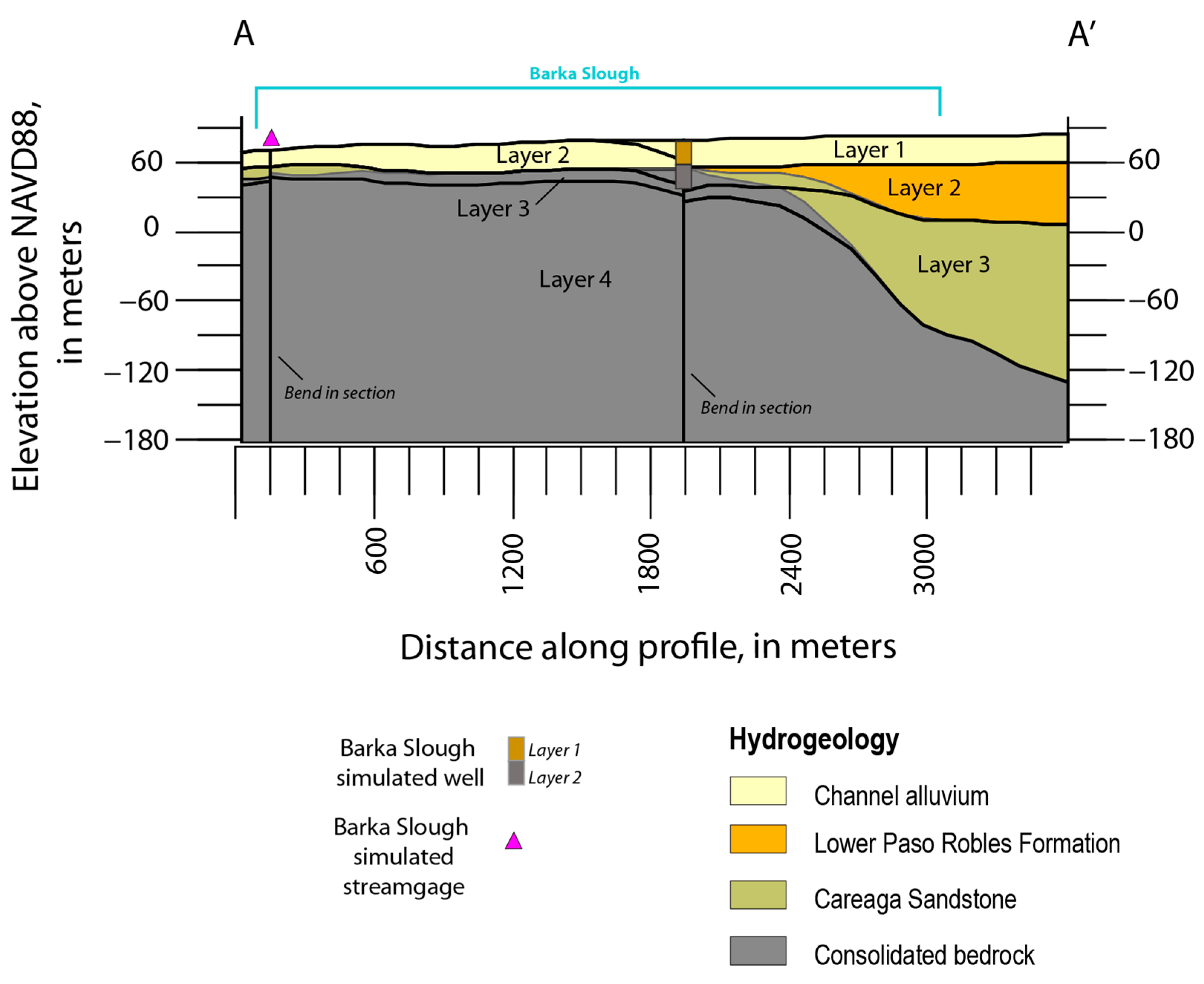

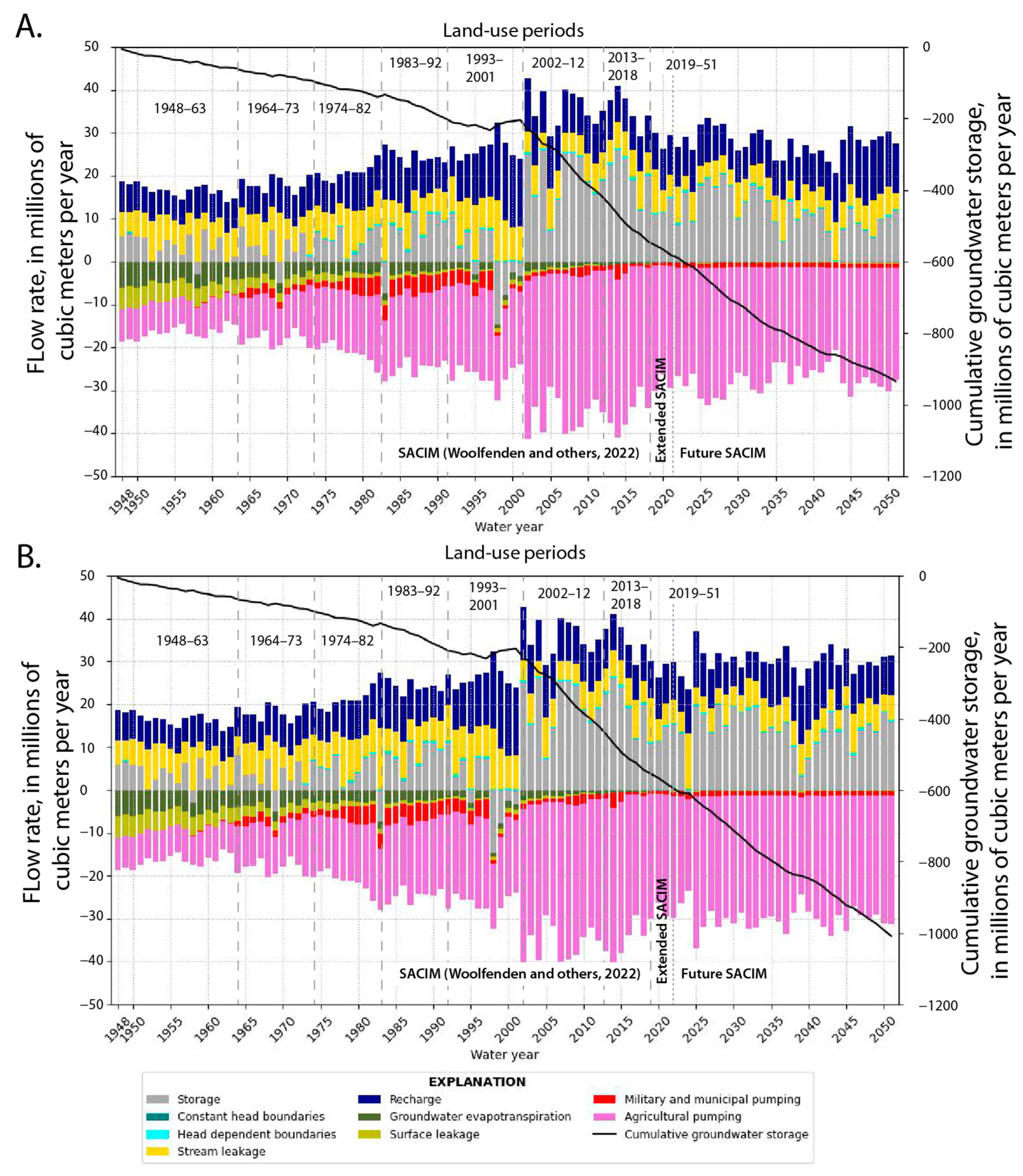
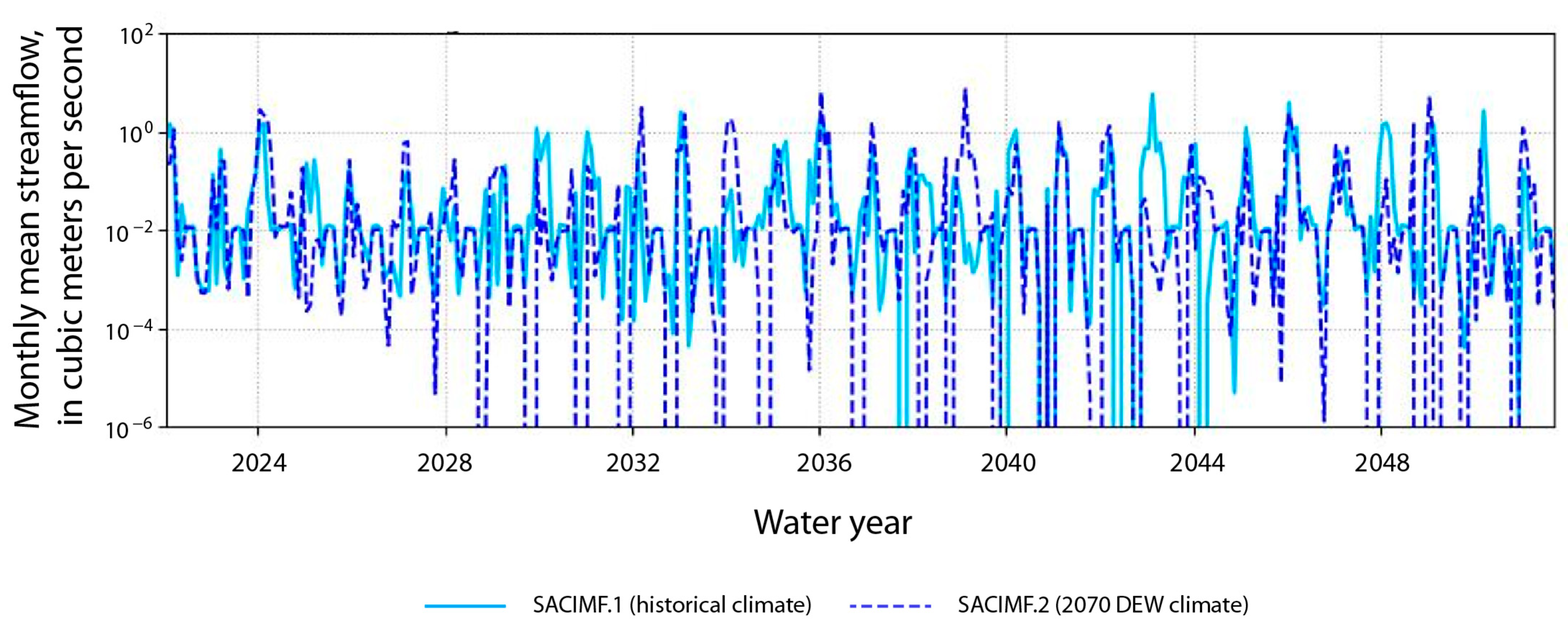
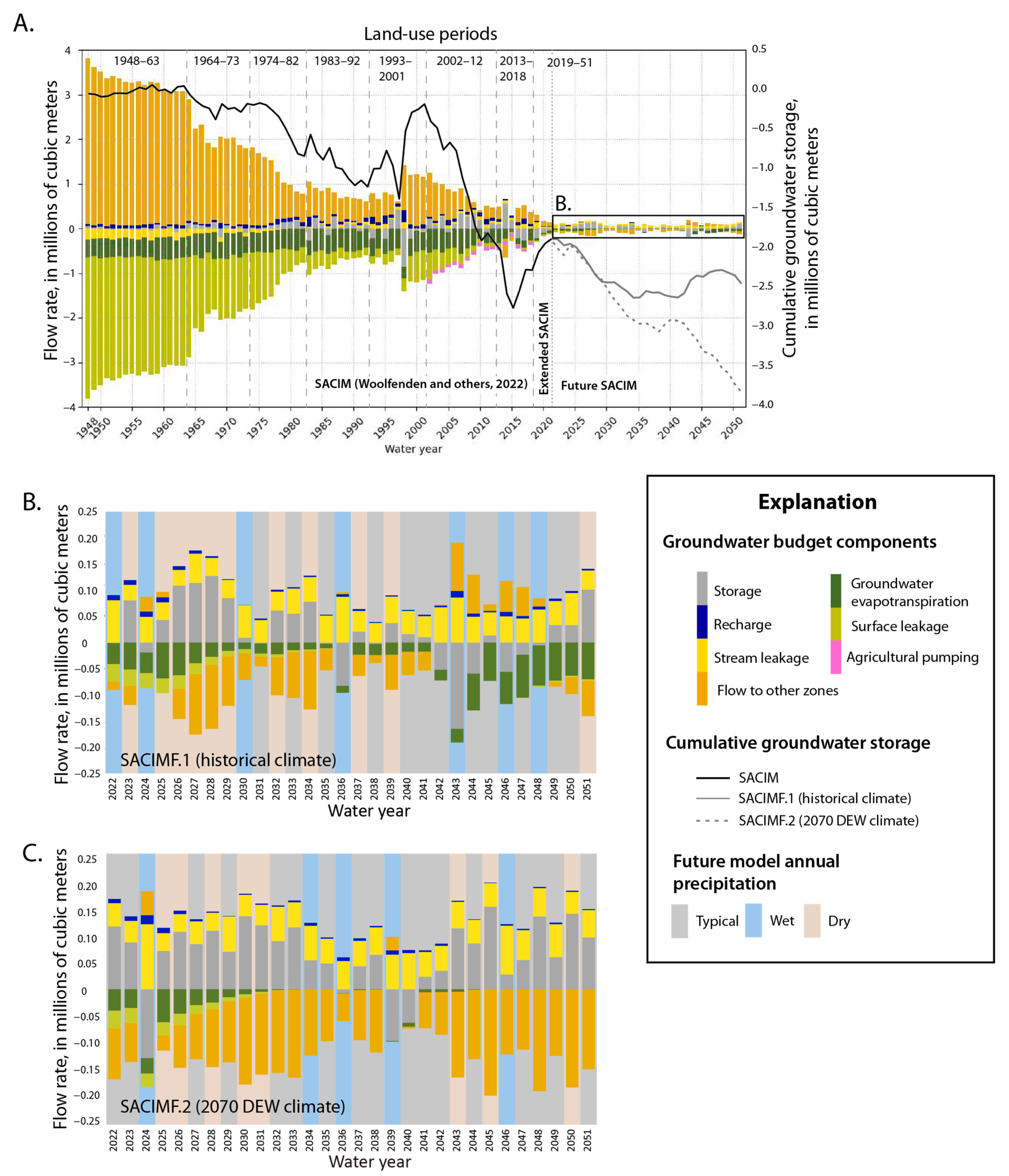
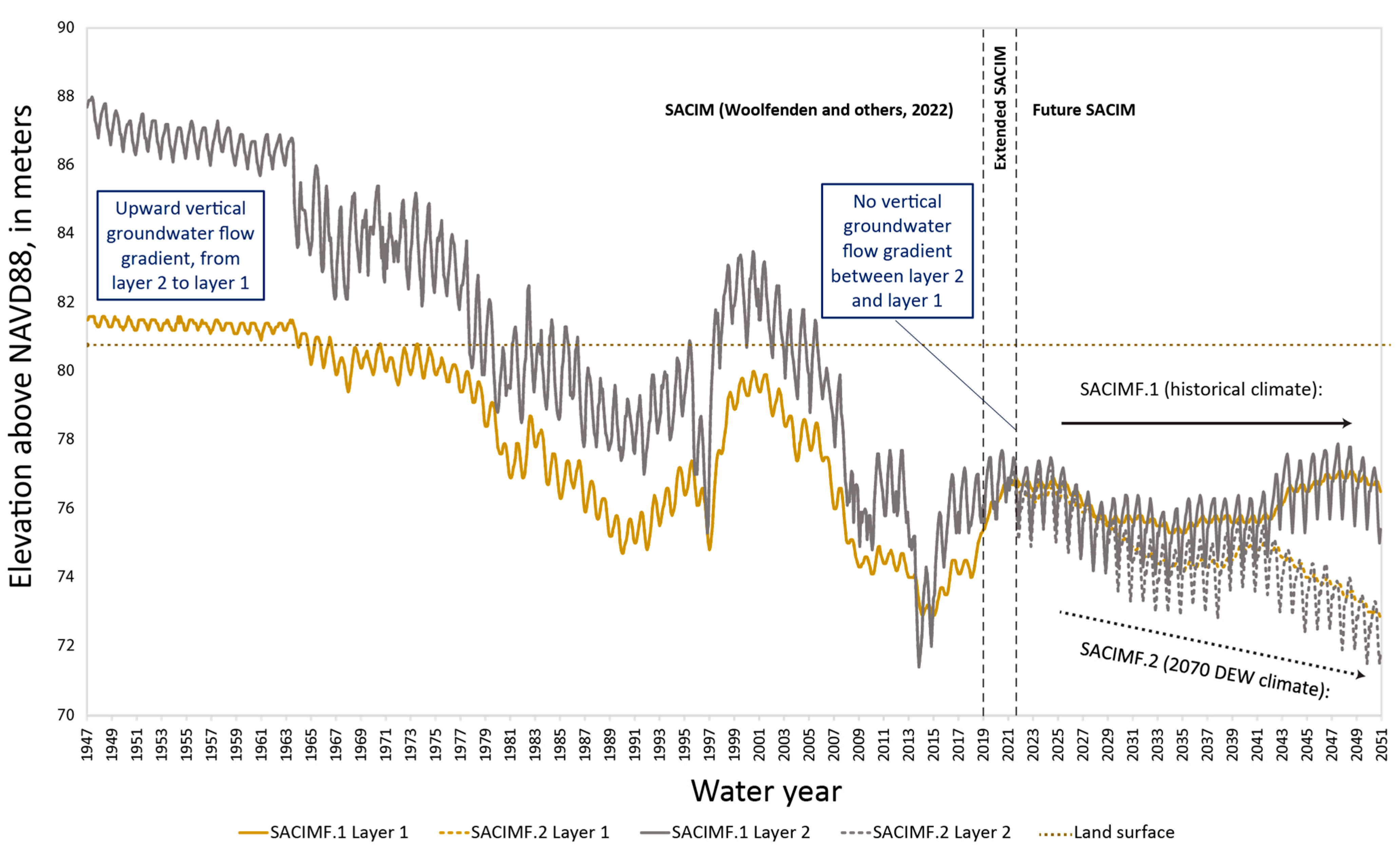
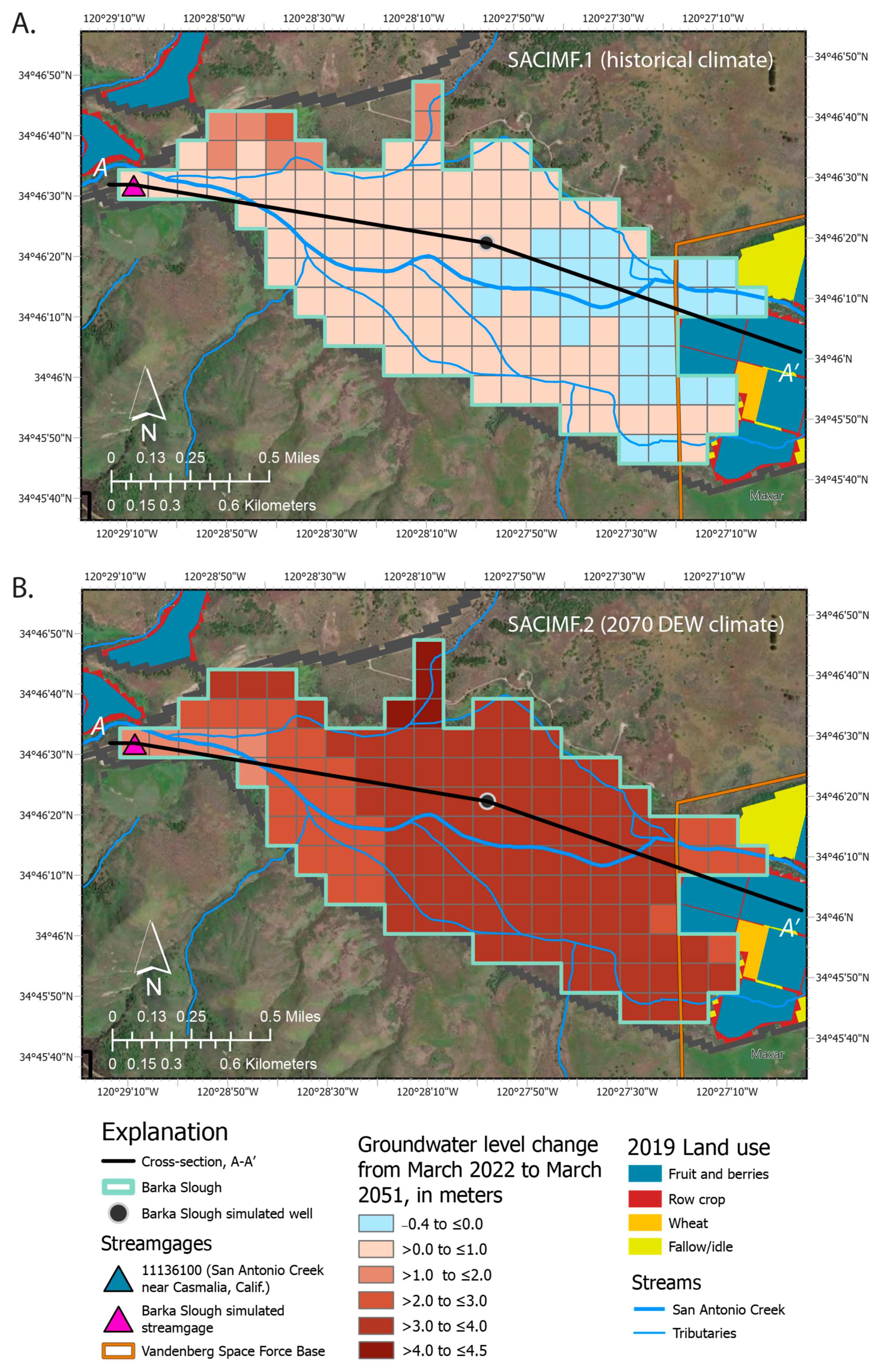

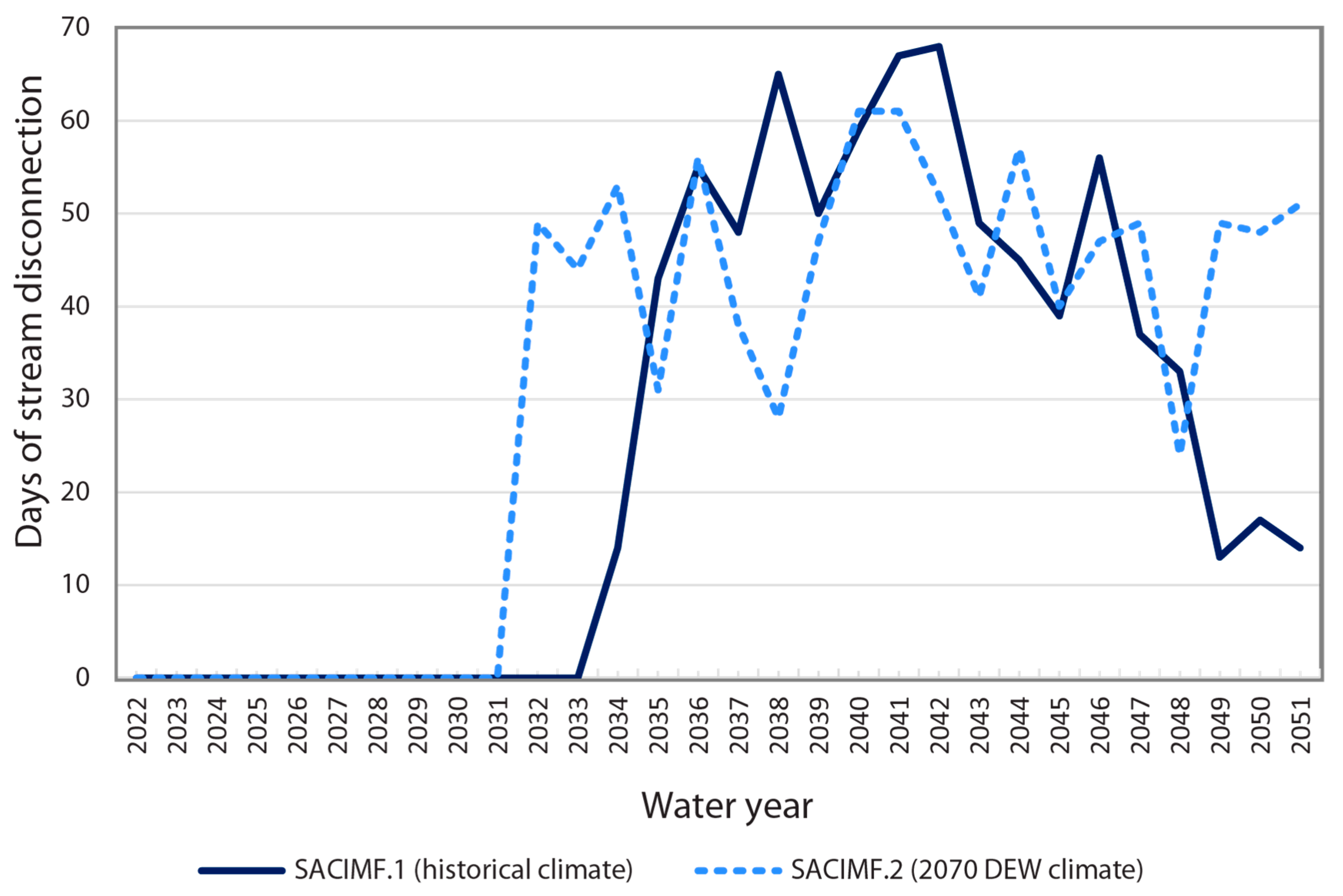
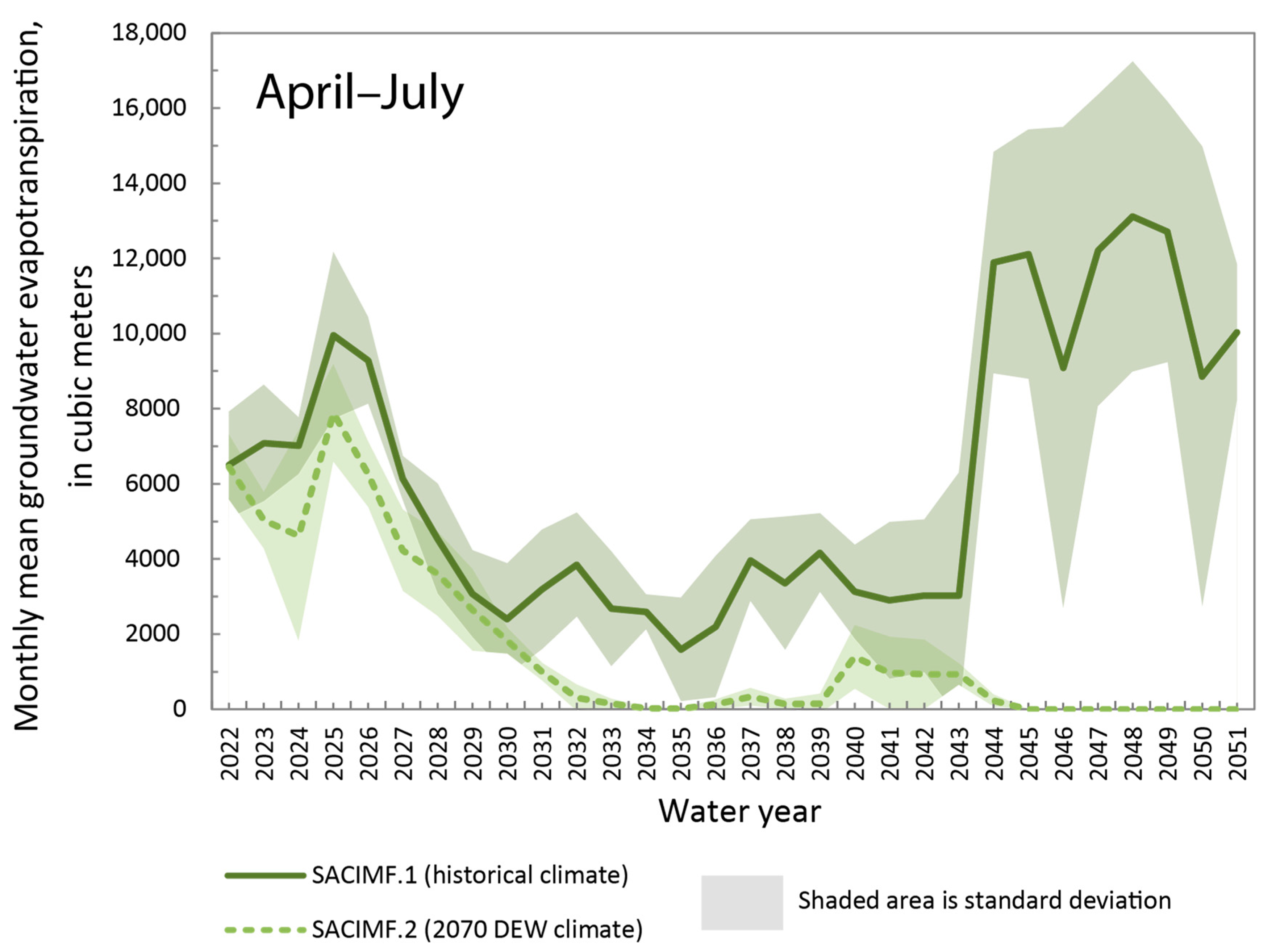
| Species | Description | Habitat Metric | Impact Severity | |||||||||||
|---|---|---|---|---|---|---|---|---|---|---|---|---|---|---|
| Jan | Feb | Mar | Apr | May | Jun | Jul | Aug | Sep | Oct | Nov | Dec | |||
| Tidewater goby, Eucyclogobius newberryi | Estuarine fish found in San Antonio Creek and its estuary. Endangered [6]. | S | ||||||||||||
| SD | ||||||||||||||
| DtG | ||||||||||||||
| Unarmored threespine stickleback, Gasterosteus aculeatus williamsoni | Freshwater and brackish fish found in San Antonio Creek and Barka Slough. Threated [7,8]. | S | ||||||||||||
| SD | ||||||||||||||
| DtG | ||||||||||||||
| California red-legged frog, Rana draytonii | The largest native frog in the western United States. Threatened [9,10]. | S | ||||||||||||
| SD | ||||||||||||||
| DtG | ||||||||||||||
| Gambel’s watercress, Nasturtium gambelii | Perennial marsh and riparian plant found in an upstream tributary to San Antonio Creek. Endangered [11]. | S | ||||||||||||
| SD | ||||||||||||||
| DtG | ||||||||||||||
| La Graciosa thistle, Cirsium scariosum var. loncholepis | Perennial wetland plant. Endangered [13,14]. | S | ||||||||||||
| SD | ||||||||||||||
| DtG | ||||||||||||||
| High impact | Moderate impact | Low impact | Minimal impact | |||||||||||
| Budgets | SACIMF.1 | SACIMF.2 | ||
|---|---|---|---|---|
| Total Flux for 2022–2051 | Average Annual Flux for 2022–2051 | Total Flux for 2022–2051 | Average Annual Flux for 2022–2051 | |
| Groundwater inflow components, in millions of cubic meters | ||||
| Boundary flow | 7.546 | 0.252 | 8.764 | 0.292 |
| Stream Leakage | 172.215 | 5.741 | 172.667 | 5.765 |
| Recharge | 292.695 | 9.990 | 293.231 | 9.774 |
| Total inflow | 479.457 | 15.982 | 474.662 | 15.822 |
| Groundwater outflow components, in millions of cubic meters | ||||
| Groundwater evapotranspiration | −4.265 | −0.142 | −2.495 | −0.083 |
| Surface leakage | −3.431 | −0.114 | −3.263 | −0.109 |
| Municipal and military pumping | −34.961 | −1.165 | −34.961 | −1.165 |
| Agricultural pumping | −790.453 | −26.348 | −861.543 | −28.718 |
| Total outflow | −833.110 | −27.770 | −902.262 | −30.075 |
| Net groundwater storage | −353.758 | −11.792 | −427.755 | −14.258 |
| Budgets | SACIMF.1 | SACIMF.2 | ||
|---|---|---|---|---|
| Total Flux for 2022–2051 | Average Annual Flux for 2022–2051 | Total Flux for 2022–2051 | Average Annual Flux for 2022–2051 | |
| Groundwater inflow components, in millions of cubic meters | ||||
| Stream Leakage | 1.485 | 0.050 | 1.559 | 0.052 |
| Recharge | 0.140 | 0.005 | 0.124 | 0.004 |
| Total inflow | 1.612 | 0.054 | 1.683 | 0.056 |
| Groundwater outflow components, in millions of cubic meters | ||||
| Groundwater ET | −1.172 | −0.039 | −0.322 | −0.011 |
| Surface leakage | −0.233 | −0.008 | −0.179 | −0.006 |
| Net flow to other zones | −0.780 | −0.026 | −3.110 | −0.104 |
| Total outflow | −2.184 | −0.073 | −3.612 | −0.120 |
| Net groundwater storage | −0.560 | −0.186 | −1.930 | −0.064 |
Disclaimer/Publisher’s Note: The statements, opinions and data contained in all publications are solely those of the individual author(s) and contributor(s) and not of MDPI and/or the editor(s). MDPI and/or the editor(s) disclaim responsibility for any injury to people or property resulting from any ideas, methods, instructions or products referred to in the content. |
© 2025 by the authors. Licensee MDPI, Basel, Switzerland. This article is an open access article distributed under the terms and conditions of the Creative Commons Attribution (CC BY) license (https://creativecommons.org/licenses/by/4.0/).
Share and Cite
Cromwell, G.; Culling, D.P.; Young, M.J.; Larsen, J.D. Simulated Effects of Future Water Availability and Protected Species Habitat in a Perennial Wetland, Santa Barbara County, California. Water 2025, 17, 1238. https://doi.org/10.3390/w17081238
Cromwell G, Culling DP, Young MJ, Larsen JD. Simulated Effects of Future Water Availability and Protected Species Habitat in a Perennial Wetland, Santa Barbara County, California. Water. 2025; 17(8):1238. https://doi.org/10.3390/w17081238
Chicago/Turabian StyleCromwell, Geoffrey, Daniel P. Culling, Matthew J. Young, and Joshua D. Larsen. 2025. "Simulated Effects of Future Water Availability and Protected Species Habitat in a Perennial Wetland, Santa Barbara County, California" Water 17, no. 8: 1238. https://doi.org/10.3390/w17081238
APA StyleCromwell, G., Culling, D. P., Young, M. J., & Larsen, J. D. (2025). Simulated Effects of Future Water Availability and Protected Species Habitat in a Perennial Wetland, Santa Barbara County, California. Water, 17(8), 1238. https://doi.org/10.3390/w17081238






